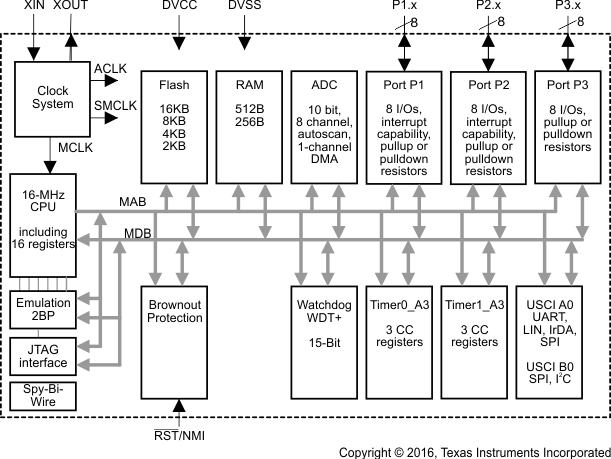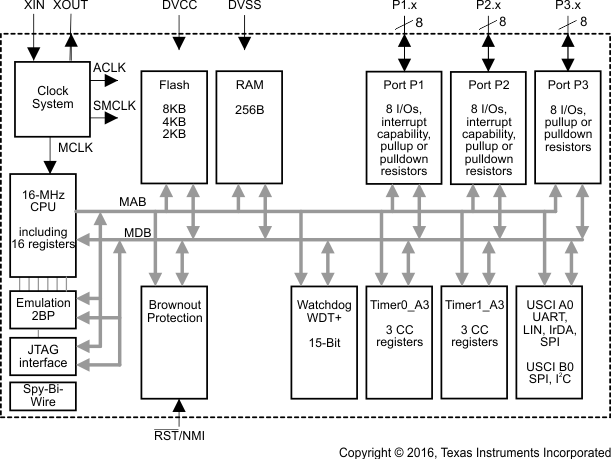SLAS734G April 2011 – April 2016 MSP430G2203 , MSP430G2233 , MSP430G2303 , MSP430G2333 , MSP430G2403 , MSP430G2433 , MSP430G2533
PRODUCTION DATA.
- 1Device Overview
- 2Revision History
- 3Device Comparison
- 4Terminal Configuration and Functions
-
5Specifications
- 5.1 Absolute Maximum Ratings
- 5.2 ESD Ratings
- 5.3 Recommended Operating Conditions
- 5.4 Active Mode Supply Current Into VCC Excluding External Current
- 5.5 Typical Characteristics, Active Mode Supply Current (Into VCC)
- 5.6 Low-Power Mode Supply Currents (Into VCC) Excluding External Current
- 5.7 Typical Characteristics, Low-Power Mode Supply Currents
- 5.8 Thermal Resistance Characteristics
- 5.9 Schmitt-Trigger Inputs, Ports Px
- 5.10 Leakage Current, Ports Px
- 5.11 Outputs, Ports Px
- 5.12 Output Frequency, Ports Px
- 5.13 Typical Characteristics - Outputs
- 5.14 Pin-Oscillator Frequency - Ports Px
- 5.15 Typical Characteristics - Pin-Oscillator Frequency
- 5.16 POR, BOR
- 5.17 Main DCO Characteristics
- 5.18 DCO Frequency
- 5.19 Calibrated DCO Frequencies, Tolerance
- 5.20 Wake-up Times From Lower-Power Modes (LPM3, LPM4)
- 5.21 Typical Characteristics, DCO Clock Wake-up Time From LPM3 or LPM4
- 5.22 Crystal Oscillator, XT1, Low-Frequency Mode
- 5.23 Internal Very-Low-Power Low-Frequency Oscillator (VLO)
- 5.24 Timer_A
- 5.25 USCI (UART Mode)
- 5.26 USCI (SPI Master Mode)
- 5.27 USCI (SPI Slave Mode)
- 5.28 USCI (I2C Mode)
- 5.29 10-Bit ADC, Power Supply and Input Range Conditions (MSP430G2x33 Only)
- 5.30 10-Bit ADC, Built-In Voltage Reference (MSP430G2x33 Only)
- 5.31 10-Bit ADC, External Reference (MSP430G2x33 Only)
- 5.32 10-Bit ADC, Timing Parameters (MSP430G2x33 Only)
- 5.33 10-Bit ADC, Linearity Parameters (MSP430G2x33 Only)
- 5.34 10-Bit ADC, Temperature Sensor and Built-In VMID (MSP430G2x33 Only)
- 5.35 Flash Memory
- 5.36 RAM
- 5.37 JTAG and Spy-Bi-Wire Interface
- 5.38 JTAG Fuse
-
6Detailed Description
- 6.1 CPU
- 6.2 Instruction Set
- 6.3 Operating Modes
- 6.4 Interrupt Vector Addresses
- 6.5 Special Function Registers (SFRs)
- 6.6 Memory Organization
- 6.7 Bootloader (BSL)
- 6.8 Flash Memory
- 6.9 Peripherals
- 6.10
I/O Port Diagrams
- 6.10.1 Port P1 Pin Diagram: P1.0 to P1.2, Input/Output With Schmitt Trigger
- 6.10.2 Port P1 Pin Diagram: P1.3, Input/Output With Schmitt Trigger
- 6.10.3 Port P1 Pin Diagram: P1.4, Input/Output With Schmitt Trigger
- 6.10.4 Port P1 Pin Diagram: P1.5 to P1.7, Input/Output With Schmitt Trigger
- 6.10.5 Port P2 Pin Diagram: P2.0 to P2.5, Input/Output With Schmitt Trigger
- 6.10.6 Port P2 Pin Diagram: P2.6, Input/Output With Schmitt Trigger
- 6.10.7 Port P2 Pin Diagram: P2.7, Input/Output With Schmitt Trigger
- 6.10.8 Port P3 Pin Diagram: P3.0 to P3.7, Input/Output With Schmitt Trigger (RHB and PW28 Package Only)
- 7Device and Documentation Support
- 8Mechanical, Packaging, and Orderable Information
Package Options
Mechanical Data (Package|Pins)
Thermal pad, mechanical data (Package|Pins)
Orderable Information
1 Device Overview
1.1 Features
- Low Supply-Voltage Range: 1.8 V to 3.6 V
- Ultra-Low Power Consumption
- Active Mode: 230 µA at 1 MHz, 2.2 V
- Standby Mode: 0.5 µA
- Off Mode (RAM Retention): 0.1 µA
- Five Power-Saving Modes
- Ultra-Fast Wake up From Standby Mode in Less Than 1 µs
- 16-Bit RISC Architecture, 62.5-ns Instruction Cycle Time
- Basic Clock Module Configurations
- Internal Frequencies up to 16 MHz With Four Calibrated Frequencies
- Internal Very-Low-Power Low-Frequency (LF) Oscillator
- 32-kHz Crystal
- External Digital Clock Source
- Two 16-Bit Timer_A With Three Capture/Compare Registers
- Up to 24 Capacitive-Touch Enabled I/O Pins
- Universal Serial Communication Interface (USCI)
- Enhanced UART Supports Automatic Baud-Rate Detection (LIN)
- IrDA Encoder and Decoder
- Synchronous SPI
- I2C
- 10-Bit 200-ksps Analog-to-Digital Converter (ADC) With Internal Reference, Sample-and-Hold, and Autoscan (See Table 3-1)
- Brownout Detector
- Serial Onboard Programming,
No External Programming Voltage Needed,
Programmable Code Protection by Security Fuse - On-Chip Emulation Logic With Spy-Bi-Wire Interface
- Section 3 Summarizes Available Family Members
- Package Options
- TSSOP: 20 Pin, 28 Pin
- PDIP: 20 Pin
- QFN: 32 Pin
- For Complete Module Descriptions, See the MSP430x2xx Family User’s Guide (SLAU144)
1.2 Applications
- Power Management
- Sensor Interface
- Capacitive Touch
1.3 Description
The TI MSP family of ultra-low-power microcontrollers consists of several devices that feature different sets of peripherals targeted for various applications. The architecture, combined with five low-power modes, is optimized to achieve extended battery life in portable measurement applications. The device features a powerful 16-bit RISC CPU, 16-bit registers, and constant generators that contribute to maximum code efficiency. The digitally controlled oscillator (DCO) allows the device to wake up from low-power modes to active mode in less than 1 µs.
The MSP430G2x03 and MSP430G2x33 devices are ultra-low-power mixed-signal microcontrollers with built-in 16-bit timers, up to 24 I/O capacitive-touch enabled pins, and built-in communication capability using the USCI. In addition, the MSP430G2x33 family members have a 10-bit ADC. See Section 3 for configuration details.
Typical applications include low-cost sensor systems that capture analog signals, convert them to digital values, and then process the data for display or for transmission to a host system.
Device Information(1)
| PART NUMBER | PACKAGE | BODY SIZE(2) |
|---|---|---|
| MSP430G2533IRHB | VQFN (32) | 5 mm × 5 mm |
| MSP430G2533IPW | TSSOP (28) | 9.7 mm × 4.4 mm |
| TSSOP (20) | 6.5 mm × 4.4 mm | |
| MSP430G2533IN | PDIP (20) | 24.33 mm × 6.35 mm |
1.4 Functional Block Diagrams
Figure 1-1 shows the functional block diagram of the MSP430G2x33 MCUs.

NOTE:
Port P3 is available on 28-pin and 32-pin devices only.Figure 1-2 shows the functional block diagram of the MSP430G2x03 MCUs.

NOTE:
Port P3 is available on 28-pin and 32-pin devices only.